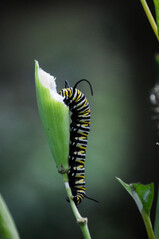Maine's butterflies and bees need your help!?
Monarch butterfly in field of wild flowers. Photo by Kelly Boland
Maine is home to a wide diversity of native insect pollinators, including many species of butterflies and moths, bees, beetles, and flies. The ecosystem services that these wild pollinators provide to natural communities and human societies is immeasurable. Without them, many wildflowers, shrubs, and trees, as well as fruits and vegetables, would not get pollinated, including important Maine crops like apples and blueberries.
Over the past few decades, several native Maine pollinators, including the monarch butterfly, rusty patched bumble bee, and hourglass drone fly have experienced significant declines throughout their ranges. Factors including habitat loss, disease, pesticides, competition from introduced species, and climate change have put these and other insect pollinators in danger of extirpation.
We can all help reverse the decline by protecting pollinator habitats. Here are a few ways to do so:
?
 |
|
Invite Summer Monarchs ? Providing summer habitat for monarch butterflies is as simple as allowing common milkweed, the sole host plant for their caterpillars and a valuable nectar source, to grow and flourish. Many other beneficial insects in Maine also feed at milkweed flowers.
Create a Bumble Bee Haven ? Bumble bees are habitat generalists, but they require an abundance and diversity of flowering plants that offer food from early spring to late fall. You can help by including an assortment of preferred pollinator flowers among your plantings during every part of the growing season.
|
 |
|
Embrace Your Wild Side ? Some of the best habitats for pollinators are ?weedy? unmowed fields and roadsides, which generally benefit from full sun and are rich in pollinator favorites like clovers, milkweeds, goldenrods, vetches, dogbanes, asters, thistles, fireweed, lupines, and raspberries. You can replicate this at home by allowing a portion of your lawn to grow tall until late fall, or by creating an unmowed border around the edge of your property. In early spring, waiting two to three weeks between mowings will allow clovers, violets, creeping groundcovers, and dandelions to bloom - providing pollinators with some of their first available nectar and pollen sources of the season. |
|
